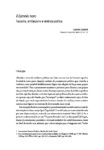Il biennio nero: fascism, antifascism and political violence Shortly after the workers’ experience of the so-called Biennio Rosso struggles in Italy between 1919 and 1920, several armed organizations of ex-combatants of the Great War and workers emerged, with the aim of resisting the violent incursions of fascist squads against popular sectors both in the city and in the countryside. The Biennio nero (1921-1922), which would mark the fascist rise to the March on Rome and the coming to power of Benito Mussolini, would nevertheless experience some episodes of popular victory in arms against fascism in an atmosphere of civil war. The main organization of this armed worker resistance by the Italian territory were the Arditi del popolo. The article intends to follow this period succinctly, with the help of recent Italian historiography, to contextualize and present Gramsci’s analysis of such historical experience, both in his texts published at the time in L’Ordine Nuovo and later in his reflections prisons. The hypothesis is that although he has deepened his theoretical analysis of political-military class relations, Gramsci never changed his mind about the need for subaltern groups to organize “illegal” forms of resistance, outside the current institutional framework, as a part of the struggle of hegemonies.
Il biennio nero Fascismo, antifascismo e violência política
Posted on IGS Archive: 11 Feb 2020
Originally published in Tempo Social (Universidade de São Paulo) | 2019
